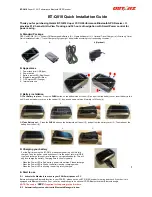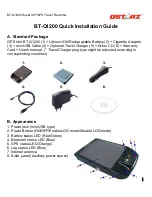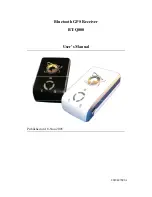
Software v3.0.9915
© Satmap Systems Ltd 2015
100
Grid.
A group of square-shaped AOIs (Areas of
Interest) in a large square/grid formation. Used to
split an area into searchable pieces by overlaying a
10 x 10 square grid onto a map (each AOI covering
300m x 300m).
Grid Magnetic Angle.
The horizontal angular
difference between Grid North and Magnetic North.
It is this angle which needs to be applied when
converting between magnetic and grid bearings.
Grid North.
The direction of a grid line which is
parallel to the central meridian on the national grid.
Heading.
Direction you are traveling.
Hibernate mode.
An ultra low power state giving
significantly extended battery life and a rapid
satellite acquisition.
Inactive route.
Shown as a gray highlighted line on
the map (only if you have made it visible).
IOI.
An Item of Interest. A non geo-referenced
document including digital information saved on
the unit that contains no latitude or longitude data.
Used to reference instructions, or contain a graphic
showing information. Can be created directly on the
unit as a simple text description with details of the
IOI shown on the description screen.
Knot.
One nautical mile per hour.
Landranger.
1:50 000 Ordnance Survey map.
LOI.
A Line of Interest. Allows you to plot a line
consisting of multiple waypoints joined together,
instead of a single POI (Point of Interest). Cannot
be followed or activated like a route, but used to
represent boundaries or alternative routes and to
customize your map.
Magnetic North.
The direction indicated by a
magnetic compass. Magnetic North moves slowly
and is currently West of Grid North in Great Britain.
Marker.
A red flag on the map from which you can
measure distance and bearing from any other point
on the map.
Meridian
. A line of longitude.
MGRS.
Military Grid Reference System, used by
NATO countries. It is derived from the UTM
grid system but uses a different labelling convention.
It does not describe a point, but rather an area.
Mil-radians.
The military use mil-radians (short for
milli-radians) because breaking down a circle into
6400 mil-radians rather than 360 degrees allows
greater accuracy.
Nautical mile.
Distance corresponding to one
minute of arc of latitude along any meridian, 1852m.
A mile (‘statute mile’) is 1609m.
OOI.
An Object of Interest. A collective term for all
'points' of interest – POI, AOI, LOI Grids, IOI. OOIs
can include rich text and pictures.
Ordnance Survey (OS).
Mapping provider for
Great Britain.
POI.
A Point of Interest. A point on a map linked to
geo-referenced data (latitude/longitude), displaying
text or images with information about that point (e.g.
hotel, restaurant, viewpoint, historical site, etc).
Primary screens.
Eight main screens that give
you access to the key GPS features: GPS MAP,
PLANNING, POSITION INFO, TRIP LOG, MAIN
MENU, COMPASS, SHARED DATA, GPS STATUS.
Rangefinder,
The distance from your location to
a given point.
Route.
A route is shown on the unit as a series of
transparent yellow or blue lines going from waypoint
to waypoint (with red arrows between waypoints).
A route may be planned either on the unit or on
a computer, and it may also be a converted trail
(known as a ‘track’).
Satellite.
A GPS satellite used by the NAVSTAR
(Navigation Signal Timing and Ranging Global
Positioning System (GPS). The first satellite in the
system, Navstar 1, was launched February 22,
1978.
SD Card.
Secure Digital card (1MB – 4GB). SDHC
is Secure Digital High Capacity (4GB – 32GB) card,
which has a different internal format. In the manual
these are also referred to as mapcards since they
are pre-loaded with
digital mapping.
Soft keys.
Buttons with functions that vary
depending on the screen displayed.
Target speed.
The speed on which Estimated Time
of Arrival calculations are based if there is no GPS
lock, or there is a GPS lock and you are stationary.
22. Glossary (Cont...)




































